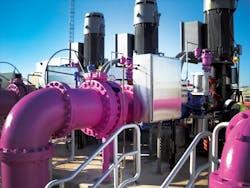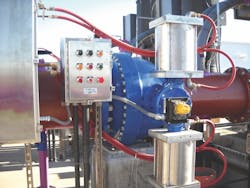Tallying Efficiency
Given the scarcity of freshwater in drought-stricken areas, water reuse projects are essential. Equipping a wastewater plant with a non-potable or reclaimed water reuse system reduces water demand, provides revenue for the water utility and reduces the costs of the outfall system.
The 900-MW Sandy Creek Energy Station in Riesel, Texas, deploys technology for coal-fueled plants utilizing steam generators and technology designed for sustainability through efficient, low-emission systems, processes and components. Moreover, the energy station’s cooling water is reclaimed water from the Waco Metropolitan Area Regional Sewerage System wastewater treatment plant located 2 miles away in Waco, Texas.
Advanced valve systems are used to deliver the reclaimed water to the energy station. The treated effluent flows by gravity to a belowground wet well for storage and pumping, where three 16-in. high-service pumps deliver the reclaimed water through a 36-in. pipeline to the energy station. Ball valves built in accordance with American Water Works Assn. (AWWA) Standard C507 were installed.
Energy Calculations
Ball valves are used for pump discharge applications because they provide energy savings. Pumps consume energy to overcome the static head and friction losses. Headloss can be converted into energy cost related to the electricity needed by the pump to overcome the additional headloss from the valve.
The energy consumption difference between two valve selections can be calculated by using the headloss difference between the two valves. For example, the difference in headloss between a 16-in. ball valve and 16-in. swing check valve operating at 10 ft per second is approximately 2.5 ft of head. Therefore, assuming the pumps run 50% of the time with an efficiency of 80% and an electrical cost of $0.08 per kW-hour for 40 years, the 40-year cost can be estimated, revealing that the use of a 16-in. AWWA ball valve can save $51,700 per valve over the life of the plant.
Valve selection can play an important role in energy savings. Moreover, saving electrical energy also reduces the need for burning fossil fuels and creating greenhouse gases. On a national average, for every kilowatt-hour of electricity used, about 1.14 lb of CO2 emissions are generated. In the previous example, the use of a ball valve instead of a swing check valve would result in savings of 368 tons of CO2 emissions per valve over the 40-year life of the system.
Valve Operation
AWWA ball valves also can control changes in flow rate to prevent check valve slam and surges in pipelines. Because ball valves are slow-closing quarter-turn valves, they are not subject to check valve slam. Further, when pipelines are several miles long, it is important for pump control valves to operate slowly. Slow operation protects the pipeline from rapid changes in velocity when the pumps are started. On long pipelines, every 1 ft per second of velocity change can create a 50-psig surge on top of the system pressure. Starting just one of the three pumps could boost the velocity in the 36-in. pipeline several feet per second, potentially causing a 200-psig surge. The solution is to control the opening and closing of the pump control ball valves slowly, over a period of 60 to 300 seconds, using an air-oil control panel powered by a routine 80-psig air supply.
While an air supply system is standard equipment, it is difficult to operate large quarter-turn valves slowly and smoothly with air, because air is compressible and does not rigidly secure the actuator cylinder during motion. The solution employed for the Sandy Creek station was to use compressed air as the supply media to an air/oil control system. Hydraulic oil also provides great lubricity and is not compressible, so the valve control is smooth and precise.
The ball valve is operated by a dual-cylinder actuator with stainless steel opposed cylinders. The top cylinder is powered with 80-psig air pressure through the four-way solenoid valve and drives the valve open and closed. The bottom cylinder is filled with hydraulic oil, which is piped to the hydraulic control panel. In the hydraulic panel, two-way solenoid valves are included to provide rapid oil flow to close the ball valve rapidly on power failure. The normal opening and closing speeds of operation are controlled by two independent flow control valves to prevent surges and water hammer in the pumping system. A make-up oil tank is needed to compensate for the difference in oil volume of the rod end and cap end of the oil cylinder.
The ball valve sequence of operation is similar to any check valve, but with a twist. When a pump is started, a pressure switch senses the discharge pressure, which sends electrical power to the four-way solenoid valve, opening the ball valve.
When the “stop” signal is given, the four-way valve is de-energized, closing the ball valve. While the ball valve is closing, the pump continues to run until the ball valve is fully closed; then a limit switch on the valve trips off the pump. The ball valve operates like a check valve, but in slow motion and with no slam.
An electrical panel displays pump operation and valve position, and provides local control of the valve. Upon receipt of a “start” signal, the pump discharge is monitored by an adjustable-pressure switch mounted on the discharge of the pipe. If the pump does not reach normal operating pressure of 110 psig within an adjustable time period of 1 to 10 minutes, a safety circuit will close the ball valve, provide an “emergency stop” signal, and lock out the system until a reset button is pressed. The panel is wired to the pump control drive for remote monitoring of conditions and helps protect the pumping system from abnormal operating conditions.

